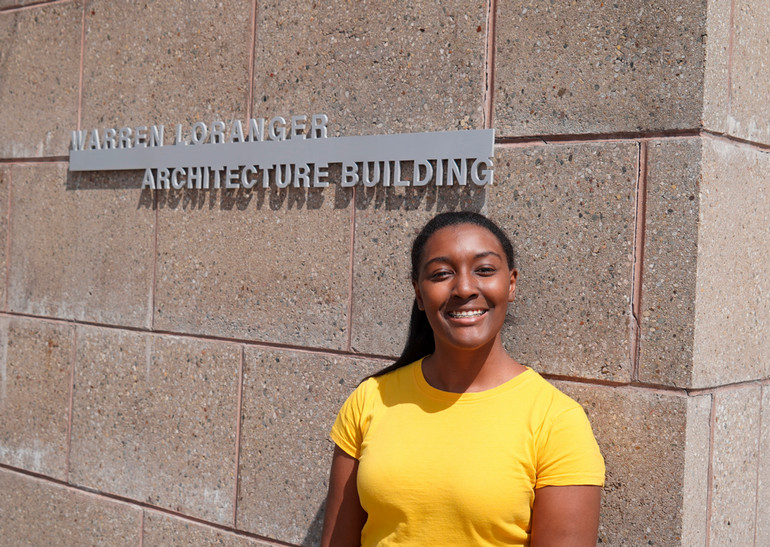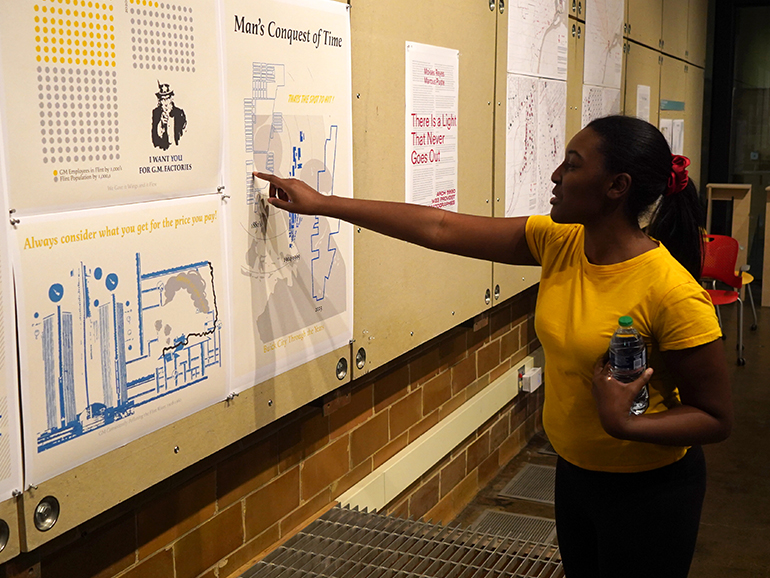Class of ’23: Graduate looks to redesign the future

To mark the graduation of the Class of 2023, Marketing & Communications is profiling several students who were nominated by staff and faculty for their contributions to the University and their potential to make a difference after graduation. Click here for more information about 2023 commencement exercises.
Though laser focused on architecture, Angel Mangham says, “I don’t have just one thing I want to do.”
That might be why her list of accomplishments is so long it reads like it is for someone much older and more experienced than the soon-to-be graduate with a bachelor’s degree in Architecture.
The Flint resident’s interest in architecture began early, when she passed by empty and abandoned lots on the way to and from her bus stop and wondered why. As she grew older, the route to the bus stop included more and more empty houses.
“I was young, and I picked up on that,” Mangham said. She won a writing contest in fourth grade writing about the issue and decided she could build something.
 The oldest of eight children attended Flint’s Mott Middle College, a high school that specializes in overlapping associate degrees with a general education high school diploma and looked for ways to learn about architecture.
The oldest of eight children attended Flint’s Mott Middle College, a high school that specializes in overlapping associate degrees with a general education high school diploma and looked for ways to learn about architecture.
“Some people don’t even know what architecture is,” she said. “And I wanted to do it. I picked a random firm and did an internship in high school, and they helped me learn some of the technology you need.”
She continued with internships and stayed an extra year at Mott and when she graduated, she had 62 college credits and a growing love of architecture.
She had her heart set on another architecture program, but after a visit she felt something was missing. When she visited Detroit Mercy’s School of Architecture & Community Development (SACD), she found what she wanted.
“It was small, and you start in the Architecture program on Day 1,” she said.
Another thing that attracted her to SACD was the diversity of students she saw.
“I could see people who looked like me doing what I wanted to do,” she remembered. “I knew this was the place.”
Her first professor in the SACD program was a Black man and that also made her feel at home. Architecture is a field that is only 23% women, 2% Black. According to the National Council of Architectural Registration Boards, there are only 566 Black women architects working today.
“I look around and see other women in class and other Blacks and I don’t get discouraged,” she said.
One especially meaningful experience was attending SACD’s Volterra study abroad program, where she studied architecture in a historic hilltop town in the heart of Tuscany. Volterra has more than 3,000 years of history, and students study the social, economic and political aspects of the area.
 Mangham extended the trip and traveled mostly alone to 17 cities in nine countries to explore the history of other cities and see how she could adapt concepts of reuse to distressed urban areas like Flint, where she hopes to use her skills to make life better.
Mangham extended the trip and traveled mostly alone to 17 cities in nine countries to explore the history of other cities and see how she could adapt concepts of reuse to distressed urban areas like Flint, where she hopes to use her skills to make life better.
Mangham has made her mark at Detroit Mercy. As president of the school’s chapter of the National Organization of Minority Architecture Students, she works to amplify the voices of Black architects.
“We do exist,” she said. As president, she organizes tours of local architecture firms, holds portfolio and resume workshops, presents a lecture series and more to help students prepare for post-graduation.
She’s also in the Honors Program, where her independent study project was on the “thin line between love and hate of buildings and how we treat them.”
The project was inspired by Flint Central High School, which closed 15 years ago, and remains standing, though abandoned.
“It was emotional research,” she said. “The building has a presence. I looked at who it was made for and why and was focused on the middle between construction and demolition. There are ways to preserve and reuse it before it ever gets to the point of tearing it down. It’s not that I don’t like designing, but I found I like redesigning more.”
Mangham is part of the Emerging Leaders Program, worked with TRIO, volunteers with the Marygrove Conservancy and Step Up, which works with fourth and fifth graders to help them become leaders. She is a member of the Student Alumni Leadership Council, which helps plan University-wide events, worked at the Detroit Collaborative Design Center, a nonprofit design company run within the SACD, and is a resident adviser in the dorms.
Why be so involved?
“You have to make your own fun,” Mangham said. “I am trying to get the most out of school, and being involved is one way. I’m kind of sad that I’m graduating, but now I get to go out in the world and make fun there.”
— By Ron Bernas. Follow Detroit Mercy on Facebook, Twitter and Instagram. Have a story idea? Let us know by submitting your idea.


